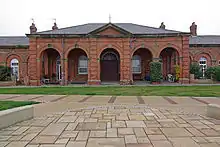
Hull & Hornsea Railway | |||||||||||||||||||||||||||||||||||||||||||||||||||||||||||||||||||||||||||||||||||||||||||||||||||||||||||||||||||||||||||||||||||||
|---|---|---|---|---|---|---|---|---|---|---|---|---|---|---|---|---|---|---|---|---|---|---|---|---|---|---|---|---|---|---|---|---|---|---|---|---|---|---|---|---|---|---|---|---|---|---|---|---|---|---|---|---|---|---|---|---|---|---|---|---|---|---|---|---|---|---|---|---|---|---|---|---|---|---|---|---|---|---|---|---|---|---|---|---|---|---|---|---|---|---|---|---|---|---|---|---|---|---|---|---|---|---|---|---|---|---|---|---|---|---|---|---|---|---|---|---|---|---|---|---|---|---|---|---|---|---|---|---|---|---|---|---|---|
| |||||||||||||||||||||||||||||||||||||||||||||||||||||||||||||||||||||||||||||||||||||||||||||||||||||||||||||||||||||||||||||||||||||
The Hull and Hornsea Railway was a branch line which connected the city of Kingston upon Hull with the seaside town of Hornsea in the East Riding of Yorkshire, England.
History
Early proposals and construction
A proposal for a railway line to Hornsea together with several other lines was part of the York, Hull and East and West Yorkshire Junction Railway (c. 1845), supported by the Manchester and Leeds Railway. As a consequence of this act entering into the 'territory' of the York and North Midland Railway alternative proposals were made by the Y&NMR, and put to parliament at the same time – both proposals included lines from near Beverley to Hornsea amongst their proposed routes.[1] The Y&NMR's line was of 10.5 miles (16.9 km) and would link Beverley (on the Hull to Bridlington Line) to Hornsea via a junction near Arram railway station north of Beverley.[2][3][4] This line was to terminate at a site near Hornsea Mere.[5] Construction of the line was passed as part of the York and North Midland Railway, East Riding Branches (No. 2) act, and included a branch from Selby to Market Weighton as well as the Hornsea branch.[6] As a result of the poor financial position the Y&NMR was placed in following the downfall of George Hudson the line and several others was postponed and not constructed.[7]
Acts were submitted in 1856 and 1861 for approval by parliament of a line from a junction on the Victoria Dock Branch Line in Hull to Hornsea.[8][9] The 1861 proposal was successful, and an Act of Parliament passed in 1862 allowing its construction. Promoted by Hornsea resident and Hull timber merchant, Joseph Armytage Wade the line was to both provide transportation to and from the agricultural region of Holderness, and to promote Hornsea as a seaside resort.[5][10] The line was to be 13 miles (21 km) in length for which the act allowed the raising of £70,000 in shares and £23,000 in loans.[11]
The first sod was ceremonially cut, by Mr Wade using a silver spade[img 1] and ornate wheelbarrow,[img 2] on 8 October 1862.[10][12]
The terminus was originally to be at Hornsea Bridge, but the plans were changed and a decision was made to extend right to the seafront — the extension required a costly viaduct over the low ground at Stream Dike. The viaduct was later replaced by an embankment.[13] The land on which the extension ran was boggy, requiring extensive piles to support the line. Consequently, the cost of construction increased from £68,000 to £122,000.
Route and operation
The line began in Hull at Wilmington railway station east of Cleveland Street (now Stoneferry Road) just to the east of the Victoria Dock Branch Line. The line then ran generally east and north towards Hornsea.[14]
The line was officially opened on 28 March 1864, with the first train departing Wilmington railway station at 12:00 noon. From 1 June 1864 traffic travelled along the newly doubled Victoria Dock Branch Line (together with trains from the Hull and Holderness Railway) into Paragon station.[15]
Although the expected traffic materialised[16] the cost overruns of the construction left the company in debt, attempts to raise further funds by share issue had failed; the line merged with the North Eastern Railway on 16 July 1866,[17] sanctioned by the "North-eastern, Hull, and Hornsea Railway Amalgamation Act" of 1866 (29 & 30 Vic., Cap 187).[18]
In 1914 there were 14 trains a day between Hull and Hornsea, including a non-stop 'express' for business commuters at 8.50 am (to Hull) and 5.18 pm (to Hornsea). Two trains ran on Sundays. At this time a typical goods locomotive on the line was the Class J type 0-6-0, passenger trains were also worked by 0-6-0 tender locomotives as well as ex-GCR Class 9Ns and ex-Great Northern Railway 4-4-2 locomotives during the L.N.E.R period.[16]
The service remained at a similar level of intensity until the 1950s, excluding reductions in frequency during the First and Second World Wars. In January 1957 Diesel multiple units had been introduced on the line.[16]
Closure of the line came as a direct result of the Beeching Report. The last passenger train ran on 19 October 1964. Goods traffic continued to use the line as far as Hornsea Bridge until 3 May 1965.
One short section was retained in north-east Hull, part of the line east of Wilmington station as far as the level crossing at Chamberlain Road provided a head shunt for trains to Wilmington cement works (see Wilmington, Kingston upon Hull), accessed via a new chord from the former Hull and Barnsley Line. The section became operational in 1968.[19] The cement works closed 1969,[20] and by the 1980s the section had been removed.[21]
Stations
| Stations on the line from Hull to Hornsea | ||||
|---|---|---|---|---|
| Station | Opened | Closed | Notes / Map reference | Current status |
| Wilmington[22] | 1864 | 1964 | Replaced by new station in 1912 on the Victoria Dock Branch Line west of the original. 53°45′35″N 0°19′48″W / 53.7596°N 0.3300°W |
Demolished. The booking office remains as a cafe. |
| Sutton[23] | Renamed Sutton-on-Hull in 1874. 53°46′55″N 0°18′26″W / 53.781900°N 0.307200°W |
Demolished. Station master's house is a private residence | ||
| Swine[24] | Staggered platforms either side of a level crossing. 53°48′15″N 0°15′54″W / 53.804200°N 0.265100°W |
Station building is a private residence | ||
| Skirlaugh[25] | 1957 | 53°49′15″N 0°14′58″W / 53.820900°N 0.249500°W | Demolished, platforms remain | |
| Ellerby[26] | 1902 1959 |
The station was a 'market station' opening only on Tuesdays. After closing to passengers in 1902 it was referred to as Ellerby siding. Renamed again to Weelerby West Siding* in 1923. 53°49′44″N 0°14′11″W / 53.829000°N 0.236300°W |
The station is a private residence. Platforms remain. | |
| Marton / Burton Constable / Ellerby[27] |
1964 | Renamed to Burton Constable on 1 August 1864, then to Ellerby* in 1922. 53°50′17″N 0°13′34″W / 53.838000°N 0.226100°W |
Station building still extant. | |
| Whitedale[28] | 53°51′05″N 0°13′08″W / 53.851500°N 0.218800°W | Station, platforms and goods yard still extant. | ||
| Hatfield / Sigglesthorne[29] |
Staggered platforms on either side of a road crossing. Renamed Sigglesthorne* in 1874. 53°52′13″N 0°12′24″W / 53.870200°N 0.206800°W |
Station house is a private residence. | ||
| Goxhill / Wassand[30] |
1953 / 1960 | A 'market day' station; services only 1 day per week. Renamed Wassand* in 1904. Closed to passengers in 1953, completely in 1960. 53°52′59″N 0°11′38″W / 53.883000°N 0.193800°W |
Station building is a private residence | |
| Hornsea Bridge[12] | 1964 | Also contained the goods facilities for the town, north of the station.[31] 53°54′15″N 0°10′16″W / 53.904090°N 0.171200°W |
Demolished | |
| Hornsea / Hornsea Town[5] |
The terminus of the Hull and Hornsea Railway, the building had a station canopy on cast iron columns. Renamed Hornsea Town in 1950. 53°54′40″N 0°09′48″W / 53.911200°N 0.163300°W |
Restored and converted to housing in 1987 after dereliction. Grade II listed building.[32] | ||
| * Stations were renamed to avoid confusion with similarly named stations on the same railway company's network – typically this occurred on expansion and on mergers | ||||
After closure
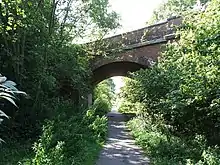
Almost the entire route today can be followed as a public footpath known as the Hornsea Rail Trail (part of the Trans Pennine Trail); many of the station buildings remain in the rural areas outside Hull. The line can also still be seen on preserved tile maps on LNER stations such as on the North Yorkshire Moors Railway.
See also
References
- ↑ For details see York, Hull and East and West Yorkshire Junction Railway.
- ↑ Morfin 1991, p. 176
- ↑ Tomlinson 1914, p. 472
- ↑ "York and North Midland Railway. East Riding Branches". The London Gazette (20545): 6659. 29 November 1845.
- 1 2 3 "Station Name: Hornsea Town". Disused Stations. Subterranea Britannica. 20 April 2010. Retrieved 25 November 2011.
- ↑ "4. Railways of Great Britain". The British Almanac of the Society for the diffusion of useful Knowledge. The Companion to the Almanac. 1847. p. 92.
- ↑ Tomlinson 1914, p. 499.
- ↑ "Hull and Hornsea Railway. (Incorporation of Company for constructing a Railway from Kingston-upou-Hull to Hornsea, with Branches, power to use the Stations and Railway of the North-Eastern Railway Company, and to make working arrangements)". London Gazette (21944): 3998–9. 25 November 1856.
- ↑ "Hull and Hornsea Railway. (Incorporation of Company; Construction of Railway from Kingston-upon-Hull to Hornsea, with two branches; Working and other Arrangements with the North Eastern Railway Company ; Power to use Railway and Stations of that Company.)". London Gazette (22569): 4905–6. 25 November 1861.
- 1 2 Gillet & MacMahon 1980, p. 278
- ↑ Tomlinson 1914, p. 607.
- 1 2 "Station Name: Hornsea Bridge". Disused Stations. Subterranea Britannica. 20 April 2010. Retrieved 25 November 2011.
- ↑ Allison, K. J.; Baggs, A. P.; Cooper, T. N.; Davidson-Cragoe, C.; Walker, J. (2002). "North Division: Hornsea". In Kent, G. H. R. (ed.). A History of the County of York East Riding. Vol. 7, Holderness Wapentake, Middle and North Divisions.
- ↑ Goode 1981, pp. 74–75
- ↑ Tomlinson 1914, p. 612
- 1 2 3 Goode 1981, p. 76
- ↑ Tomlinson 1914, p. 625
- ↑ Rickards, George Kettilby (1866). The Statutes of the United Kingdom and Ireland. Vol. 27 Part II, 29 & 30 Vic. 1866. p. 66.
- ↑ Bairstow, Martin (1995). Railways in East Yorkshire. Vol. 2. p. 50. ISBN 1871944120.
- ↑ Moore, Dylan (2011). "Cement Kilns - Wilmington". www.cementkilns.co.uk. Retrieved 25 June 2014.
- ↑ Ordnance Survey. 1:10000. 1982–4
- ↑ "Station Name: Willmington". Disused Stations. Subterranea Britannica. 20 April 2010. Retrieved 25 November 2011.
- ↑ "Station name: Sutton-on-Hull". Disused Stations. Subterranea Britannica. 2 November 2010. Retrieved 25 November 2011.
- ↑ "Station Name: Swine". Disused Stations. Subterranea Britannica. 20 April 2010. Retrieved 25 November 2011.
- ↑ "Station Name: Skirlaugh". Disused Stations. Subterranea Britannica. 20 April 2010. Retrieved 25 November 2011.
- ↑ "Station Name: Ellerby (2nd station)". Disused Stations. Subterranea Britannica. 20 April 2010. Retrieved 25 November 2011.
- ↑ "Station Name: Ellerby". Disused Stations. Subterranea Britannica. 20 April 2010. Retrieved 25 November 2011.
- ↑ "Station Name: Whitedale". Disused Stations. Subterranea Britannica. 20 April 2010. Retrieved 25 November 2011.
- ↑ "Station Name: Sigglesthorne". Disused Stations. Subterranea Britannica. 20 April 2010. Retrieved 25 November 2011.
- ↑ "Station Name: Wassand". Disused Stations. Subterranea Britannica. 20 April 2010. Retrieved 25 November 2011.
- ↑ Goode 1981, p. 75
- ↑ Historic England. "Former Hornsea Railway Station, Railway Street (1249389)". National Heritage List for England. Retrieved 28 November 2011.
Sources
- British Railways Pre-Grouping Atlas And Gazetteer. Ian Allan Publishing. 1958–1997. ISBN 0-7110-0320-3.
- Butt, R. V. J. (October 1995). The Directory of Railway Stations: details every public and private passenger station, halt, platform and stopping place, past and present (1st ed.). Sparkford: Patrick Stephens Ltd. ISBN 978-1-85260-508-7. OCLC 60251199. OL 11956311M.
- Gillet, Edward; MacMahon, Kenneth A. (1980). "Chapter 21: Railways". A History of Hull. Oxford University Press. ISBN 0-85958-448-8.
- Goode, C. T. (1981). "Chapter 10: Into Holderness". Railways of East Yorkshire. The Oakwood Press. ISBN 0-85361-280-3.
- Morfin, John (1991). "Chapter 12: Railways to the Yorkshire Coast". In Lewis, David B. (ed.). The Yorkshire Coast. Normandy Press. ISBN 0-9507665-3-4.
- Price, Peter (1989). Lost Railways Of Holderness, The Hull Withernsea and Hull Hornsea Lines. Hutton Press Ltd. ISBN 0-907033-86-5.
- Tomlinson, William Weaver (1914). North Eastern Railway, Its Rise and Development. David & Charles.
Images
- ↑ "Spade". Hull Streetlife museum collection. Hull City Council.
- ↑ "Rhinoceros wheelbarrow". Hull Streetlife museum collection. Hull City Council.
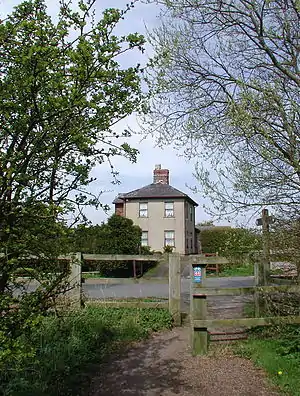 Swine station (2008)
Swine station (2008)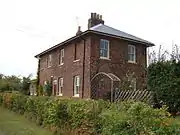 Ellerby station building (2009)
Ellerby station building (2009)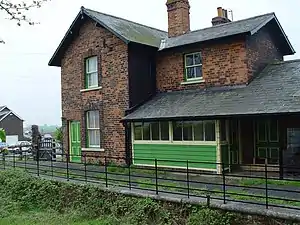 Whitedale station (2005)
Whitedale station (2005)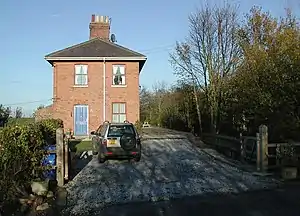 Sigglesthorne station (2007)
Sigglesthorne station (2007)
External links
- Hull and Hornsea railway Historical images, timetables, tickets and other publisher material, via www.hornseyoldandnew.co.uk
